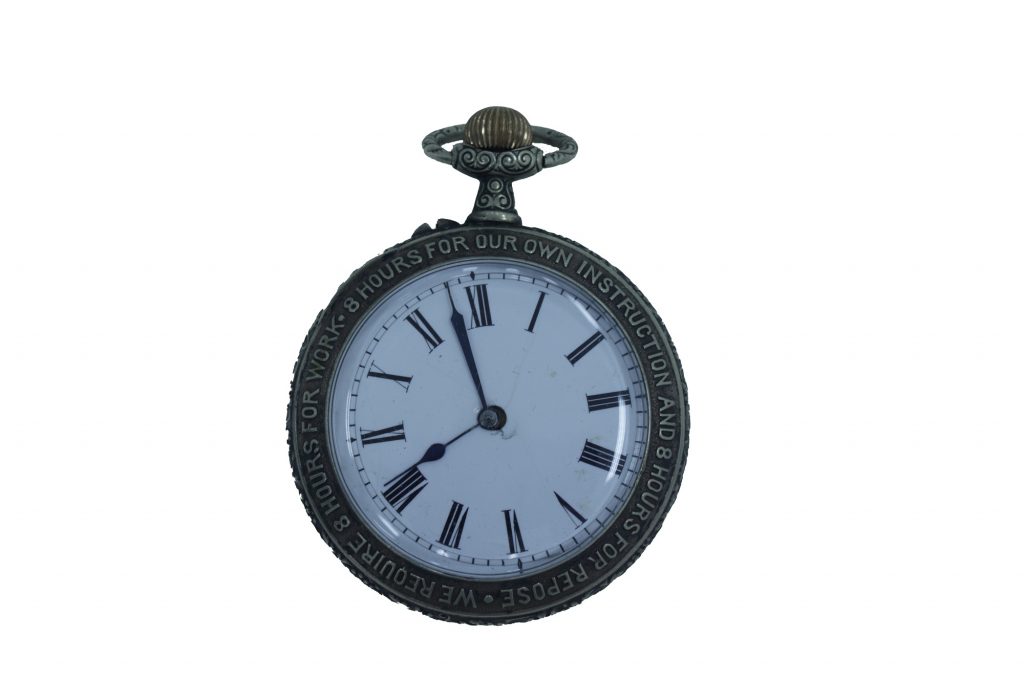
What’s that for? An Eight-Hour Watch
Laura Groschopp and Eleonora Roldán Mendivil | 29 April 2022
Why is, of all things, a small English pocket watch of great importance in the history of the workers’ movement? Laura Groschopp from the Communication Department and Eleonora Roldán Mendivil from the Education Department get to the bottom of this question in the exhibition “Karl Marx and Capitalism”.

The “Struggles and Movements” section of the exhibition includes a pocket watch, on display in a glass cabinet. What makes this watch so special is that it is an “eight-hour watch”, and its engraved inscription reflects an earlier period in the struggle for workers’ rights and improved labour conditions. The campaign for the eight-hour day was a perennial feature of demands made on 1 May, which is still celebrated as International Workers’ Day in a great many countries.
The lettering framing the dial states one of the core demands of the 19th century workers’ movement: “We require 8 hours for work 8 hours for our own instruction and 8 hours for repose.” On the back case, this radical slogan is underscored by the guiding principle of the international workers’ movement that applied across the continent and beyond: “Workingmen of every country unite together to defend your rights.”
This inscription runs in a circle along the rim of the casing. This call to arms is encapsulated in an image of two workers shaking hands, united by a female figure. With a diameter of six centimetres, the pocket watch is one of twelve watches of this kind that were made, presumably in the 1860s, to mark the assembly, in London, of the International Working Men’s Association (better known as the First International). It is thus one of the earliest examples of the eight-hour watch, so called, not because of the number of hours on its dial, but because of the demand expressed in its inscription. In the 1880s, such watches also started being produced in Germany and Italy.
The demand for the eight-hour day, assertively proclaimed on the pocket watch, was first expressed by Karl Marx at the Geneva Congress of the International Workingmen’s Association in September 1866, when he stated: “We propose 8 hours’ work as the legal limit of the working day.” The reason for such a demand was the increasing pressure exerted by employers on workers during industrialization. It was not uncommon for factory labourers to have a standard working day of 14 hours, with some even having routine shifts of 16 hours a day. Such conditions and, among other things, the widespread use of child labour, gave rise to a counter-movement that aimed to limit the power of the factory, mill, and mine owners: workers went on strike to press their fundamental demands for more humane working hours, improved working conditions, and higher pay.
The labour movement in Europe was initially loosely organized and did not yet have sufficient strength and influence to attain its goals, especially that of imposing an eight-hour day. The new industrial cities in the USA and Canada became an important driving force for the international labour movement. The experiences of European immigrants boosted the movement’s strength – but also led to its increasing radicalization on the other side of the Atlantic.
On 1 May 1886, half a million workers from a wide range of industries downed tools in the USA in an effort to have the standard working day reduced from twelve hours to eight. One radical labour organization involved in the action was the Knights of Labor, whose members included both skilled and unskilled workers, people of different ethnic backgrounds, and Black workers. The American Federation of Labor, meanwhile, welcomed neither unskilled labourers nor women and also barred African-Americans from joining its ranks. It, too, called for a strike. The largest rally in Chicago’s Haymarket Square drew a crowd of some 90,000 people.[1] Chicago had grown massively in the previous decades due to rapid industrialization and the wave of European immigration that came with it. Quite a few of the immigrants were “forty-eighters”, experienced and embittered radicals from all corners of Europe who had taken part in the failed anti-monarchist revolutions of 1848 and 1849.[2]
After three days of police violence to intimidate protesters and protect strikebreakers in Chicago, several people were left injured and one worker died. Events escalated at one rally on 4 May, when a bomb was thrown at police. Dozens of officers were wounded and seven killed. In retaliation, the police fired indiscriminately into the crowd. Four strikers died. Seven Europeans (most of them German-born) and one American, known collectively as the Chicago Eight, were found guilty of the police deaths on the grounds of political incitement. Four were executed, while four were later pardoned.[3]
In 1890, the Second International declared 1 May (or May Day) International Workers’ Day and a day of class struggle, in commemoration of the Haymarket Affair. However, the reduction in working hours that the workers’ movement would eventually bring about were still not enshrined in law. It was not until around 1900 that parliamentary regulations on working hours were passed in many European countries. On 23 November 1918, the eight-hour day was enshrined in law in Germany. However, the struggle to improve working conditions did not end there, and trade unions continue to fight for the interests of the working population today.
[1] For more on the history of May Day in Germany, see: https://www.youtube.com/watch?v=KeoFlqbFZLw
[2] Friederike Hausmann (1998): Die Deutschen Anarchisten von Chicago oder warum Amerika den 1. Mai nicht kennt, Berlin, p. 44.
[3] The Haymarket Square Riot & the Fight For Workers Rights, https://www.youtube.com/watch?v=wHRL4hlYJvg, Friederike Hausmann (1998): Die Deutschen Anarchisten von Chicago oder warum Amerika den 1. Mai nicht kennt, Berlin.
 © DHM/Thomas Bruns |
Eleonora Roldán MendívilEleonora Roldán Mendívil is a political scientist and has been doing her PhD on the relationship between exploitation and oppression in modern capitalism at the University of Kassel since 2020. Since 2016, she has been teaching at various universities and colleges on the history and theory of capitalism, the workers’ and women’s movement and (anti)colonialism, among other topics. She has been an education officer in the Education and Outreach Department of the DHM since May 2021. |
Laura GroschoppLaura Groschopp is an art historian and cultural manager with a scientific focus on communication, image and media history and fashion photography. She was responsible for strategic and digital communication as well as marketing and media relations for various institutions. She has been working in the DHM’s communication department since September 2021. |
 © DHM/Thomas Bruns |